3—
Search for Identity:
Architecture of National Pavilions
The style is not a clearly determined one, or rather, it is a mixture of styles borrowed from mosques, caravansaries, private houses.
A visitor to the 1878 Universal Exposition, quoted in Sylviane Leprun, Le Théâtre des colonies
At the international expositions, the architecture of the main Islamic pavilions was based on that of the homeland—its key monuments and, to a lesser degree, its residential and commercial structures. The style was predominantly "Islamic," except in the Egyptian section, where there was always a "temple" in the style of an ancient Egyptian kingdom.
Two types of pavilions stood out in the Islamic sections: the replica of a building from back home and the exhibition hall per se. Replicas were sometimes artifacts themselves, serving their original functions and therefore introducing social and cultural traits of the represented country. The mosque was a major focus of curiosity as a symbol for Islam that appealed to the sense of religious otherness defining Muslim societies for Westerners. The first exhibition mosque was built in 1867 by the Ottoman Empire in Paris; others appeared regularly at subsequent fairs.
Like the exhibition mosque, the model residential structure, displayed as an artifact, made its debut in 1867 in the Egyptian, Ottoman, and Tunisian pavilions,[1] along with various public structures, such as fountains. In some cases, the replicas were adapted to new functions according to exhibition needs. Thus an Egyptian "temple" might be a museum, and a bath, or even a mosque, might be a marketplace.
The exhibition hall was not modeled directly on any known building but was designed to fit the requirements of the national display. Algeria's exhibition hall in a neo-Islamic style in 1878 set a powerful precedent: it synthesized indigenous architecture by combining elements from various monuments. This eclecticism allowed large-scale fragments (such as portals, minarets, and towers) to be integrated into the new composition.
Although the Islamic pavilions were often similar and were thus perceived as belonging to a single cultural tradition, their architecture in fact varied according to the politics, culture, and wealth of the particular country. This chapter
analyzes the national pavilions chronologically, starting with those erected by the Ottoman Empire. During the period considered here, 1867–1900, the empire maintained its political sovereignty while gradually losing its economic independence. The long struggle in the empire between modernization and the preservation of a historical identity intensified during these years.
The Ottoman Empire
Sultan Abdülaziz's desire to partake in the cultural life of Europe was reflected in the meticulous attention given to the design and construction of the Ottoman pavilions for the 1867 Universal Exposition in Paris. As noted in the preceding chapter, the Ottoman Empire was represented at the 1867 fair by an ensemble of buildings-as-objects: a mosque, a residence, a bath, and a fountain. Ottoman agricultural, industrial, and artistic products were displayed in the main exhibition halls. The 1867 pavilions marked a turning point in Ottoman architectural history as the end products of a theoretical study whose terms were defined in Europe. Although the change appears to have been enforced from the outside, it should be understood within the general framework of Westernizing reforms undertaken by the ruling elite. French architects initiated and practiced the academic approach, but it was endorsed wholeheartedly by the Ottoman commissioners to the exposition. Furthermore, the Ottoman buildings at the 1867 fair themselves affected European architectural thought. If they heralded a new theoretical viewpoint from which the Ottoman architectural heritage could be assessed and recycled, they also revised European architects' and architectural critics' stereotypes of Islamic architecture as a merely sensuous play of decorative devices.
The Ottoman pavilions were designed in Istanbul by a self-trained French architect named Léon Parvillée in collaboration with the Italian architect Barborini. Parvillée had been commissioned earlier by the Ottoman government to document and restore the fourteenth-seventeenth century monuments of Bursa.[2] An ardent follower of Eugène-Emmanuel Viollet-le-Duc, the proponent of rationalism in nineteenth-century architecture, Parvillée sought to discover some of the "rules" of Ottoman architecture in his measured drawings of Bursa's buildings. For example, in the Mausoleum of Mehmed I (known as the Green Mausoleum because of its colored tile facades) he discovered that the
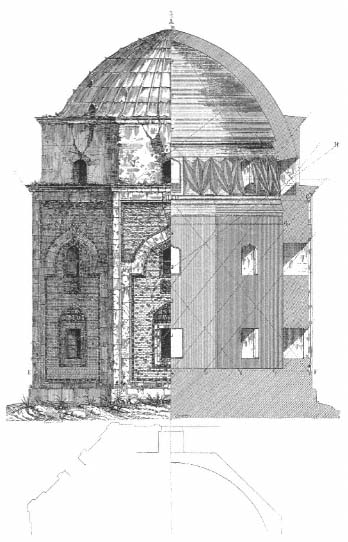
Figure 55.
Parvillée's drawing of the Mausoleum of Mehmed I
(Gazette des architectes et du bâtiment, special issue,
Paris, 1867).
height of the interior space from the floor to the top of the dome was obtained by the superposition of two Egyptian triangles, whose height equals five-eighths of the base (Fig. 55). On the basis of geometric analyses, Parvillée argued that Ottoman monumental architecture and its decoration were systematic and that the triangle was the primary form of geometric composition.[3] In Architecture et décoration turques (Paris, 1874), Parvillée presented his discoveries as a "key, a link, a reasoned explanation [une explication raisonnée ]" of the
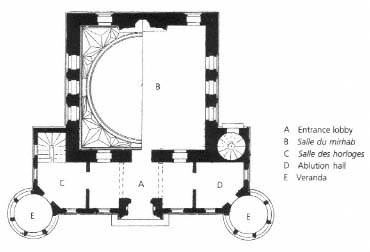
Figure 56.
Parvillée, plan of the mosque, Paris, 1867 ( Gazette des architectes
et du bâtiment, special issue, Paris, 1867).
compositional principles of Ottoman architecture. He claimed that he was correcting the interpretation of "Oriental art" as purely a product of fantasy.[4]
Viollet-le-Duc wrote the preface to Architecture et décoration turques, praising Parvillée's studies for their "spirit of examination and analysis, necessary for the discovery of truth in the sciences just as in the arts." Parvillée, he continued, demonstrated the role of "cold science" in these artistic productions, which on the surface seemed to belong to a world of dreams.[5] In his analyses Parvillée took part in a broad contemporary debate. The concern with science and geometry in architectural design and the links between Islamic architecture and geometric principles were widely discussed in France, and not only in Viollet-le-Duc's circle. For example, César Daly, a prominent architect and architectural theorist, in his review of Owen Jones's Plans, Elevations, Sections, and Details of the Alhamhra (1842–46), emphasized that "geometry [was] the base of all form studies" and that "to become a great artist, one had to combine science and art," science meaning geometry in this context.[6]
A similar line of thought was pursued by Anatole de Baudot, who reviewed Parvillée's pavilions in the Gazette des architectes et du bâtiment .[7] Baudot, looking for a theoretical premise in the Ottoman architecture in the 1867 fair, concluded that these buildings were based on harmonic proportions, in accord with Viollet-le-Duc's theory of proportions. Baudot felt that the pavilions of other countries lacked the serious, instructive, and novel aspects of the Ottoman (and Egyptian) pavilions. Although they amused the public, such structures failed to inform and interest the architect.[8]
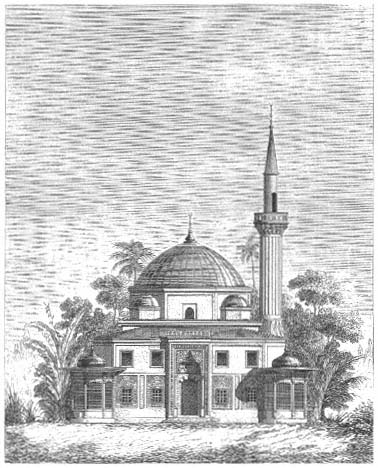
Figure 57.
Parvillée, facade of the mosque, Paris, 1867 ( Gazette des
architectes et du bâtiment, special issue, Paris, 1867).
The "rules" of Ottoman architecture "discovered" by Parvillée and acclaimed by Baudot and Viollet-le-Duc have not been challenged by historians of Ottoman architecture. While their premise is open to question, their impact was concrete in the Ottoman pavilions in 1867, which appeared as an awkward marriage of Ottoman architectural forms and the rules of French academicism.[9]
The mosque had a main hall, called the salle du mihrab by Parvillée, as well as a rectangular room divided into three parts: the ablution hall, the salle des horloges, and the entrance lobby where shoes were stored (Figs. 56–59). Two
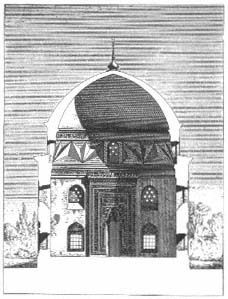
Figure 58.
Parvillée, section through the mosque,
Paris, 1867 (Gazette des architectes et
du bâtiment, special issue, Paris, 1867).
round symmetrical "verandas" framed the mosque. There were no precedents in Ottoman mosque types for such an arrangement of spaces and functions. Ablution fountains were either outside—in the courtyards or along the facades—or at the center of interior halls under large domes, as in the fourteenth- and fifteenth-century Bursa examples. A salle des horloges and verandas were not components of mosques. The architect thus had integrated these new elements into his mosque, using Ottoman forms to create a symmetrical Beaux-Arts plan. The verandas, for example, were shaped like sebil s, "drinking fountains." The only element breaking the symmetry was the inevitable minaret. Parvillée demonstrated his knowledge of Ottoman architecture and his sensitivity to scale and proportion by not doubling this element for the sake of symmetry. According to Théophile Gautier, because of Parvillée's care in reducing the scale of the Bursa mosque by exactly one-half, the re-creation gave the same impression as the original. The ornamentation, however, already very delicate in Bursa, became much too "cute" (mignonne ) for Gautier.[10]
Baudot approved Parvillée's use of a "very original" geometric canvas as well as his juxtaposition of green, blue, white, and yellow tiles on a blue background. The rich harmony of the decoration and the variety of its geometric combinations seemed to Baudot to offer valuable lessons to contemporary artists.[11]
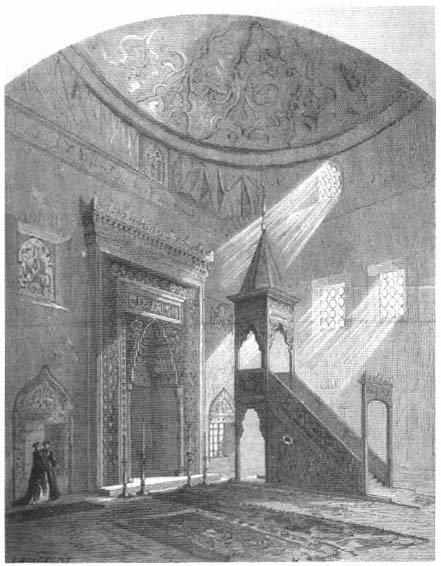
Figure 59.
Interior view of the mosque, Paris, 1867 ( L'Exposition universelle de 1867 illustrée ).
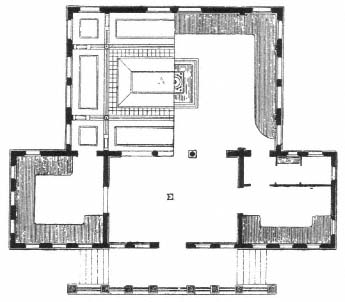
Figure 60.
Parvillée, plan of the Pavillon du Bosphore, Paris, 1867
(Gazette des architectes et du bâtiment, special issue,
Paris, 1867).
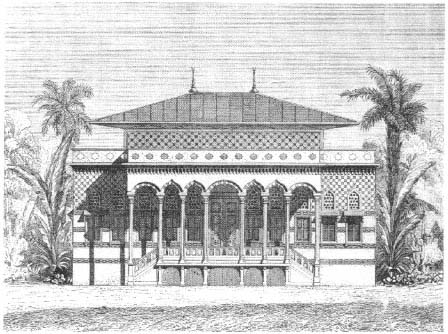
Figure 61.
Parvillée, facade of the Pavillon du Bosphore, Paris, 1867
(Gazette des architectes et du bâtiment, special issue, Paris, 1867).
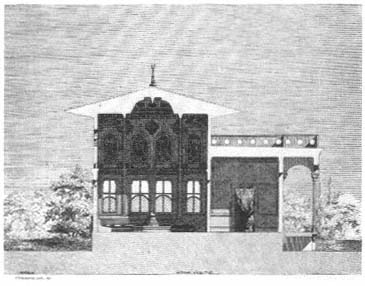
Figure 62.
Parvillée, section through the Pavillon du Bosphore, Paris, 1867
(Gazette des architectes et du bâtiment, special issue, Paris, 1867).
The residential structure, the Pavillon du Bosphore, consisted of a vestibule and a main hall (Figs. 60–63). The vestibule opened to a terrace and had service rooms at either end that communicated with the large main room,[12] which was surrounded by a built-in divan covered with colorful fabric. The water in the small pool in the center was perfumed with jasmine.[13] Baudot found the exterior of the building "picturesque and agreeable in its proportions but very simple." Inside, however, the main room was interesting, especially for its colors and light. Daylight entered at two levels from three sides, softened by the stained glass of the lower level's windows. The lower interior wall was defined by the windows and simple woodwork, the upper one by decorative panels; the ceiling was exquisitely detailed in wood. The dominant colors inside were green, blue, red, and white. Arguing once again that modern European art should learn how to use this rich resource, Baudot concluded that the contemporary French interior, covered with papier-mâché and "loud paintings," was "shabby" (mesquin ) and banal by comparison.[14] Such sentiments about ornamentation were not restricted to the architectural community but were also expressed in the popular press. One reporter wrote: "Ah, we Occidentals, who believe that we know all about the refinement of luxury; there is a lot for us to learn from the Orientals . . . on the art of interior decoration."[15]
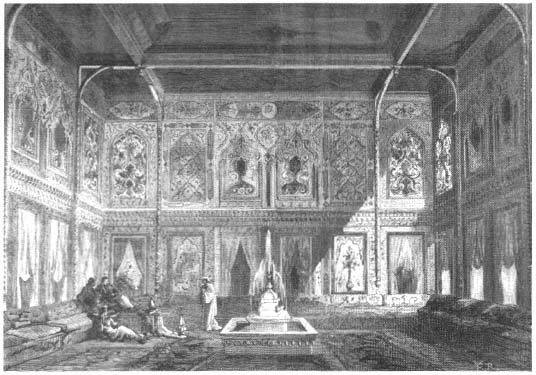
Figure 63.
Interior of the Pavillon du Bosphore, Paris, 1867 ( L'Exposition universelle de 1867 illustrée ).
Parvillée's bath had three rooms: a dressing room (at right in Figs. 64–65), a warm room (center), and a main room, lined with benches, with a small pool in each corner (left). A dome pierced by small lanterns in the Ottoman fashion rose over the main room. Symmetry was achieved on the exterior by a second dome over the dressing room. For Baudot, the point here was the faithful repetition of an Ottoman building type.[16]
Baudot was cautious in basing any conclusions about Ottoman architecture on these pavilions. He admitted that the construction raisonnée of Ottoman architecture could not be clearly understood through these temporary structures, but he claimed nonetheless that the high quality of their interior decoration, along with the coherence (unité ) and the "rather significant frankness of expression" of these structures, made them interesting to study.[17] Within the general framework of late nineteenth-century Western architecture, the key
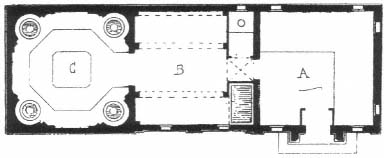
Figure 64.
Parvillée, plan of the bath, Paris, 1867 ( Gazette des architectes
et du bâtiment, special issue, Paris, 1867).
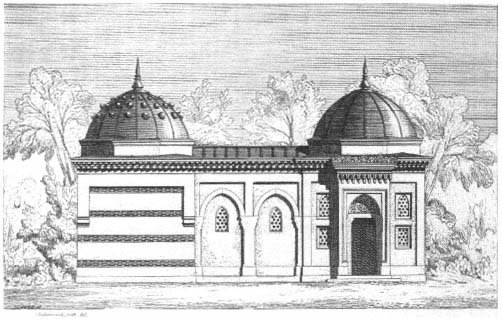
Figure 65.
Parvillée, facade of the bath, Paris, 1867 ( Gazette des architectes et du bâtiment,
special issue, Paris, 1867).
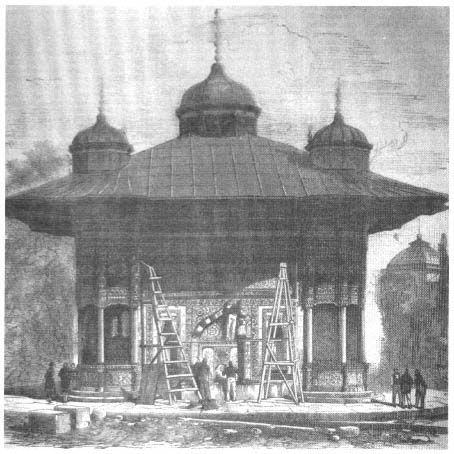
Figure 66.
Ottoman pavilion, Vienna, 1873 (L'Esposizione universale di Viena, no. 3).
terms are "coherence" and "frankness of expression," the interrelated goals of the time.
The "Ottoman style" (Osmanli biçiminde ) pavilion of the 1873 Vienna exposition, a replica of the Sultan Ahmed Fountain near Hagia Sophia in Istanbul, records a similar concern with historical precedent (Fig. 66). The Sultan Ahmed Fountain is a small pavilion with a sebil at each corner from which water and sherbet were served to the public. The elaborately carved facades and the rounded corners reflect a baroque influence on eighteenth-century Ottoman architecture in Istanbul. There were several reasons to exhibit this building abroad: its scale was appropriate for pavilions; it was a highly visible
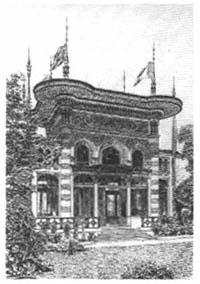
Figure 67.
Pavilion of Turkish Tobacco,
Paris, 1889 (Bibliothèque
Nationale, Département des
Estampes et de la Photographie).
public monument belonging to the recent past; it was a fresh interpretation of Ottoman forms under European influences; and, finally, it was a playful structure.
The 1873 building, unlike the pavilions of 1867, was a faithful full-scale copy. Ottoman artisans had crafted the details of the facade panels, and most of the materials (such as the tiles of the overhanging eaves) were brought from Turkey. Authenticity was a primary goal.
The other two Ottoman buildings erected in Vienna in 1873 were looser interpretations of Ottoman styles. The Sultan's Treasury was a two-story centralized structure, covered with a high dome, that may have derived from royal mausoleums (see Fig. 28). Outside, it had a large staircase to the main level and arcaded projecting porches. Because the building housed a valuable collection of jewels, its design was deliberately "luxurious" in detail.[18] Indeed, due to the exorbitant amount of money spent on it, the government ordered that some of the furniture be reused. The magnificent display cases were later placed in schools, museums, and other public buildings at home.[19]
The architecture of the Sultan Ahmed Fountain was recycled in the 1889 Paris exposition in the Pavilion of Turkish Tobacco (Fig. 67). Although it was
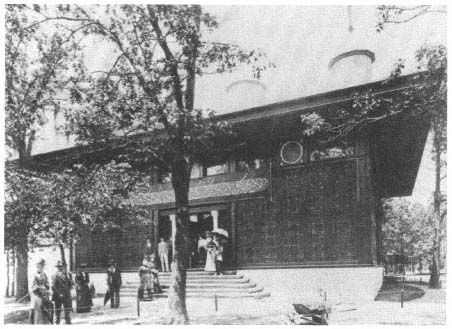
Figure 68.
Ottoman pavilion, Chicago, 1893 (World's Columbian Exposition, vol. 2).
not a major presence at this fair, with its overhanging roof, tripartite facade, rounded corners, and clearly delineated horizontal bands, it came to represent Ottoman architecture. As mentioned earlier, the Ottoman government had chosen not to participate in this exposition.
At the 1893 World's Columbian Exposition in Chicago the main Ottoman pavilion, placed with other national pavilions in Jackson Park, away from the Midway Plaisance, again referred to the Sultan Ahmed Fountain, described now as a "landmark of splendor and magnificence" by an Ottoman spokesman (Fig. 68). But the Chicago pavilion experimented with an approach different from that of the Vienna pavilion, for it was designed as an exhibition building—a new and consciously created type. Built on a larger scale than the fountain, the 1893 pavilion interpreted the formal and decorative principles of the historical structure, editing out some features (the curving sebil s at the corners) and adding others (the stairs leading to the central entrance). The pavilion's tripartite facade was simpler than that of the fountain. The rectangular structure, boxier than the original, had an overhanging roof, which further emphasized
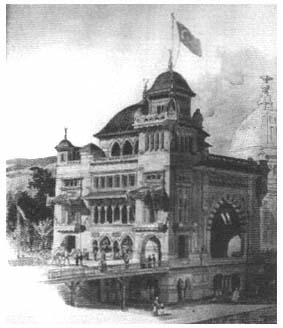
Figure 69.
Ottoman pavilion, Paris, 1900 (L'Esposizione
universale del 1900 a Parigi ).
its horizontality. Although the roof with its eaves and domes mimicked that of the Sultan Ahmed Fountain, the arches over the side door and windows, with their pointed tops (not visible in Fig. 68), were departures from the original model. The exterior decoration of the stone fountain was evoked in the wood panels of the facades, "carved in arabesques and traceries," fabricated in Damascus by local artisans and shipped to Chicago.[20] The orthogonal panels created an overall planar effect. This was almost a "modern" building, and according to some sources it was designed by a Chicago architect named J. A. Thain, although the scheme was specified by the imperial commission.[21]
The Ottoman pavilion at the 1900 Universal Exposition in Paris was an elaborate exhibition hall on the Rue des Nations (Fig. 69; see also Fig. 50). As if to compensate for its absence from the 1878 and 1889 expositions, the Ottoman government spent the considerable sum of $70,000 on the 1900 pavilion, designed by the French architect Adrien-René Dubuisson. A two-story porch delineated by a vast pointed arch dominated the riverfront. The structure had a bazaar, artisans' workshops, and a café on the ground floor; an in-
dustrial exposition on the first floor; and, on the second floor, a military museum modeled after the Military Museum in the Church of Hagia Eirene in Istanbul and a theater where operettas representing vignettes from Turkish life were performed.[22] Unlike other, earlier, Ottoman pavilions, which borrowed easily recognizable fragments from well-known monuments and combined them anew, this building made no direct reference to particular Ottoman monuments; it was an experiment in a broadly defined neo-Islamic style.
Western observers were puzzled by the style of this pavilion. An American observer described it as a "handsome structure, but Turkish throughout"; he seemed pleased that "no critic had yet ventured to place it in the renaissance style."[23] Others used known references to explain it. One French writer thought that Dubuisson had been inspired by "the most beautiful monuments of Constantinople, in particular the Mosque of Süleyman from the mid-seventeenth century [sic ]," accepted by many as the high point of the Turkish style. This same writer linked the great arch facing the river with the Mosque of Sultan Qaytbay in Cairo from the late Mamluk period, which had no relation to the "Turkish" architecture of Istanbul.[24] Another observer saw in it elements of architecture from the mosques of Qaytbay, Süleyman, Beyazid, and Murad IV as well as from Hagia Sophia and the Fountain of Top-Hane.[25] Still another proposed that here was a brilliant synthesis of pure Ottoman architectural forms:
Under the pretext of Orientalism, only Arab art—true or imitation—has been presented to us Occidentals until now. But Monsieur Dubuisson is showing us at last, for the first time, pure Ottoman art. . . . Here the eminent architect has made a synthesis of Ottoman art. In an ensemble that he brilliantly conceived, he grafted the important parts and true details of the most beautiful monuments of the pure style of Turkey.[26]
The discrepancies among the accounts reflect the building's potpourri of forms and elements, in most cases highly reinterpreted, from Islamic architecture of different periods and regions. Several buildings erected in Istanbul toward the end of the nineteenth century reveal a similar eclecticism—for example, the 1889 Terminal of the Orient Express, designed by the German architect Jachmund, who incorporated references from several regions of Islam (Mamluk, Moorish, and Ottoman) into the facades of a technologically advanced structure that was a well-established "type," the train station (see Fig. 103).
Egypt
The architecture of the Egyptian section in the 1867 Paris exposition was a major undertaking, similar in size and ambition to that of the Ottoman quarter. The Egyptian buildings, designed by Jacques Drévet and E. Schmitz, however, were products of a school of thought diametrically opposed to Parvillée's. Drévet did not write about his ideas, but they were described by Charles Edmond, the commissioner general of the Egyptian display, in L'Egypte a l'Exposition universelle de 1867:
We would be impetuous to look for a rule or a law in the development of Arabic architecture; it does not exist. The Orient lacks this ordering spirit that our Occident has brought to everything it has created since the Germanic invasion; in its place, the arbitrary and the capricious reign. Therefore, we are not trying to describe the architectonic system of Arabs; they don't have anything like it; and just as the diverse elements of their buildings are disconnected, the history of their art is also disjointed.[27]
Edmond argued that the details of Egyptian monuments were "capricious." The Arabs "tormented the dome in a thousand ways," and they made the arch go through "charming tortures"; the colonette arabe, far from displaying the rigorous proportions of the Greek column, was thin, svelte, and fragile. A true characteristic of this art was the "arabesque," into which "the Arab had poured his whole heart and a soul full of fire."[28]
The Egyptian section, like the Ottoman, contained a replica of a residential structure (Fig. 70). The selamlik was divided into an exposition hall and a pavilion de repos for Isma'il Pasha on his visits to the fairgrounds.[29] The building had a symmetrical cruciform plan, expressed on the exterior by large projections. A dome, covered with arabesques and terminating in a golden crescent, crowned the tower at the center; it was supported by horseshoe-shaped arches on delicate columns. Alternating bands of blue and white lined the facades; the crenellated roofline was white. An entrance portal (at right in Fig. 70), leading to the khedive's private rooms, dominated the main facade, it was framed by a double arch of red and white marble.[30] The two side doors (one visible at left in Fig. 70) served as public entrances.
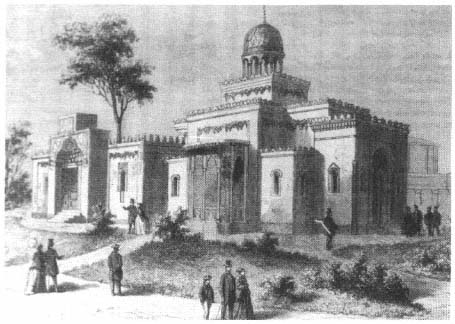
FIigure 70.
Palace of the khedive, Paris, 1867 ( L'Exposition universelle de 1867 illustrée )
Inside, a "great sobriety of colors and lines" generated "a quiet harmony," but bright colors and light enlivened the verandas. The atmosphere created by Drévet's decorative scheme, executed by French artisans from the Maison Bernard et Mallet,[31] recalled that of the Gamaliyya Palace in Cairo, where the khedive was born. Although Drévet's structure was a "perfect palatial example," it also embodied the main theme of Egyptian Muslim architecture according to Charles Edmond: "In an Arab building, everything is decoration, and the beauty of the ensemble depends on the harmonic and difficult fusion of the details."[32]
Egypt also brought the okel, a commercial building type, to the exhibition in 18O7 (Figs. 71–73). Despite its historic references, this building represented the arts and crafts of modern Egypt, the "living Egypt, the Egypt of Isma'il Pasha"; Edmond pointed out that its parallels in Western architecture were the arcades, the Parisian galleries.[33] Attached to it was a barn that sheltered two dromedaries and two donkeys.[34]
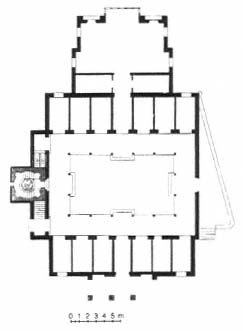
Figure 71.
Drévet, plan of the okel, Paris, 1867
(Gazette des architectes et du bâtiment,
special issue, Paris, 1867).
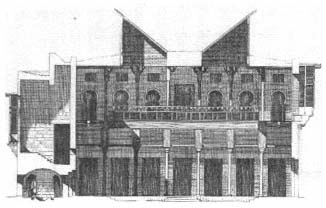
Figure 72.
Drévet, section through the okel, Paris, 1867 (Gazette
des architectes et du bâtiment, special issue, Paris, 1867).
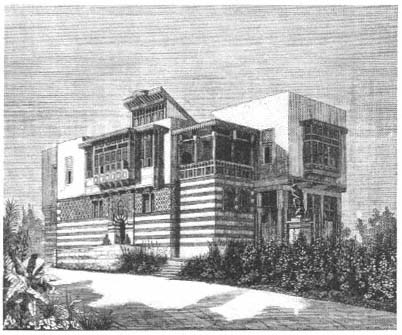
Figure 73.
View of the okel, Paris, 1867 (Gazette des architectes et du bâtiment,
special issue, Paris, 1867).
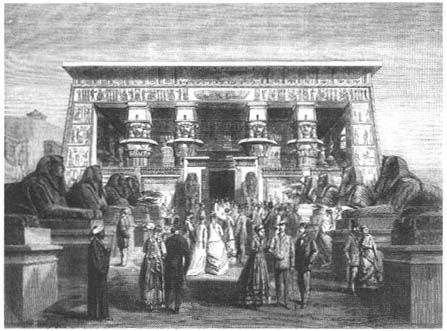
Figure 74.
Egyptian temple, Paris, 1867 (The Illustrated London News, 16 November 1867).
In the West an okel is more commonly known as a caravansary, a wholesale market that also provided rooms for travelers. Drévet's interpretation of this structure was considered an interesting use of Egyptian architectural forms and construction methods in modern buildings.[35] Its general outline and details were adapted from several okels —including those in Aswan (the okels of Shaykh 'Abd al-Mansur and Sidi 'Abdallah); the musharabiyya s duplicated those of the Gamaliyya Palace and the Husayn Bey Residence in Cairo.[36] Drévet's okel was a rectangular two-story structure with arcades on both stories and a covered central court, which had a fountain at its center.[37] On the ground floor was a café and shops that faced each other along the length of the building. Here "Oriental hospitality was demonstrated by free coffee, chibouk, and narghile, and music was performed."[38]
The second story of Drévet's okel, like the first, was given over to commerce. Artisans embroidered and made jewelry, lace, saddles, and harnesses; vendors sold fancy pipes, mats, and various trinkets.[39] On this floor was also
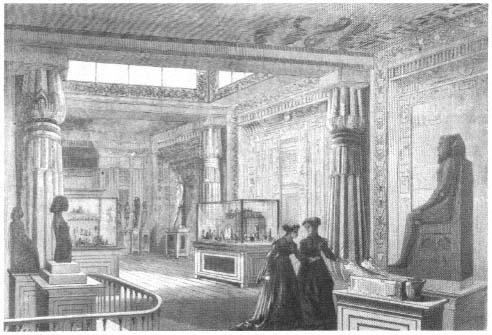
Figure 75.
Interior of the Egyptian temple, Paris, 1867 ( L'Exposition universelle de 1867 illustrée ).
the popular "anthropological museum," where hundreds of skulls (some dating from the Egyptian antiquity) and mummies from different centuries were displayed.[40] The second-floor rooms had projections with musharabiyya s, which gave the building a picturesque exterior and created playful effects of light in an interior French rationalist architects praised for its details: the doors had a "correct scale" and a "happy proportion"; the woodwork of the musharabiyya s demonstrated a remarkable compositional integrity because of "grids of great rigidity" yet "varied design."[41]
The Egyptian temple at the 1867 exposition was not in an Islamic style but looked back in Egypt's history (Figs. 74–75)—" A living lesson in archaeology," in Mariette-Bey's words,[42] which demonstrated the keen interest at the time in Egyptian antiquity and the direct role of French scholars in the field. The Egyptologist Mariette-Bey had selected articles for display here from Bulaque Museum, which he himself had established. As a member of the commission nominated by Isma'il Pasha to organize the exhibition, he had also
collaborated closely with the architect Drévet in the design of the pavilion. Mariette-Bey's preference to replicate the Temple of Philae prevailed; for him the temple was not "to embellish the exposition uselessly,"[43] but to show the entire world a "magnificent summary" of antique Egypt. Charles Edmond argued that this building and the artifacts in it reconstructed the oldest ideas of human civilization, from religion, arts, industry, customs, and traditions to the great heroes and feats of the past.[44]
An avenue of sphinxes led to the temple because every temple had to have its own "sacred way." The rectangular building itself measured 18 by 25 meters; it was 9 meters high. Slightly tapered pillars defined the four corners. Four columns on the shorter side and seven on the longer supported the entablature and the corniche, which gave the roof its strong horizontality. The design of the interior had to diverge from the Philae model. To bring in sufficient light for a public exposition hall, a glass roof was erected; "the few rays of light that Egyptians distributed mysteriously in their sanctuaries" would not have been enough. The interior divisions of the original structure were also discarded. Everything else, however, was realized with "the greatest authenticity in the ensemble and in minute detail," down to the colors. To achieve the exact proportion of the columns and other elements, precise measurements and photographs were taken at Philae.[45] With the decoration replicated on the interior walls, the illusion of authenticity was so complete that visitors claimed they felt surprised and strangely uprooted when they first encountered this temple, which seemed to belong to the banks of the Nile.[46]
The architecture of the ancient kingdoms became an accepted symbol of Egypt. In 1878 Mariette-Bey, now commissioner general of the Egyptian exposition, introduced to Paris a dwelling from Pharaonic times, a "severe" cubical building with two massive towers flanking the main facade (Fig. 76). The structure was based on his own archaeological discoveries in the town of Abydos; because some of his archaeological documentation was ambiguous, the dimensions were approximate. The facade details were not exact copies but derivations. Although this building, like the 1867 temple, was intended as a museum for the display of antiquities from the Bulaque Museum, the French organizers of the exposition decided to exhibit these objects, together with other antique works, in the galleries of retrospective art. Thus Mariette-Bey's pavilion became an exhibition hall for the art and industrial products of modern Egypt.[47]
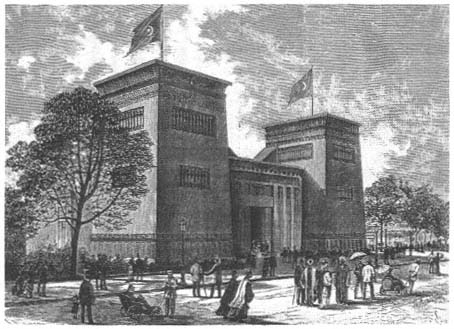
Figure 76.
Egyptian temple, Paris, 1878 (L'Illustration, 31 August 1878).
The Pharaonic house was the only pavilion representing Egypt in the exposition of 1878. The khedive had intended to bring the three epochs of Egyptian history (Pharaonic, Arabic, and modern) to Paris, in the spirit of the 1867 exposition, and "to demonstrate by contemporary monuments the state of Egyptian civilization in three principal periods of its long duration," that is, under the pharaohs, the Arabs and Ottomans, and the reigning dynasty.[48] But financial difficulties arising from the Russo-Turkish war forced a more modest display: medieval Egypt was reduced to the authentic facade of a house inside the Trocadéro Palace, and modern Egypt was architecturally absent.[49]
An Egyptian structure, following the guidelines established in the Paris expositions, appeared again in Chicago in 1893 (see Fig. 44). The Temple of the Sacred Bull on the Cairo Street was a "somber building . . . relieved with hieroglyphic writing containing biographical sketches of the Pharaohs, the history of the worship of the sacred bull, of Osyrus, and the various gods." The obelisks in front of the temple were dedicated to the United States, to Colum-
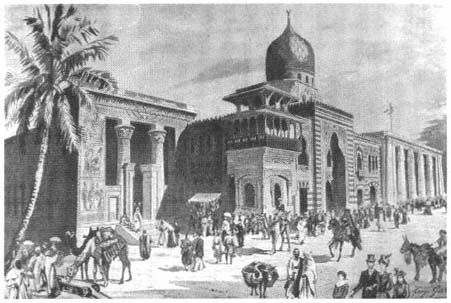
Figure 77.
Egyptian palace, Paris, 1900 (L'Esposizione universale del 1900 a Parigi )
bus, to the World's Fair, and to President Grover Cleveland. The pavilion served as a museum of antiquities.[50]
The Egyptian Palace in Paris in 1900 was a curious complex composed of three buildings: temple, okel, and a new invention: the theater with a temple facade (Fig. 77). The French architect Marcel-Lazare Dourgnon had based his design for the palace on several well-known monuments: the portico, for example, was inspired by the Temple of Dandur, whereas the principal section was based on the monuments of Memphis and Thebes. Visitors found the exterior of the pavilion "very beautiful" but considered the interior, containing ancient collections and funerary chambers, disappointing, more or less empty and "vulgar," with "nothing new" in it. Its only attraction was the theater, which featured two hundred dancers.[51] The complaints suggest that the exoticism of Egypt had been overexploited and no longer appealed to French audiences.
The okel, like the temple, reappeared at successive fairs—as an independent structure in Vienna in 1873 and as a component of the Egyptian palace in Paris in 1900. In each case it referred to several models. The portal of the Parisian
okel of 1900, for example, derived from the Cotton Market (Khan al-Khalili) in Cairo, whereas the projecting cubical section at one of its corners was a faithful copy of the Sabil al-Gamaliyya, again in Cairo.[52]
The architectural ambition of Egypt's national pavilions reflected its economic and political status. As a semi-independent province, struggling to detach itself from the Ottoman Empire and searching for a firmer alliance with European powers, the Egypt of Isma'il Pasha sent a grand display to the 1867 exhibition, emphasizing its national self-image and complex historical heritage. With the downfall of Isma'il Pasha, Egypt had to curtail any grand plan for the 1878 exposition. When Egypt submitted to British rule in 1882, the scale, ambition, and character of its presence at the fairs changed. In 1889 the Egyptian section, financed by individual entrepreneurs, represented a street in Islamic Cairo, popular as an entertainment zone; and the Cairo Street in Chicago in 1893 functioned solely as an amusement strip.
Iran
The Iranian presence at the world's fairs began modestly. In 1867 in Paris, the Persian park, located next to the Egyptian quarter, consisted of a small kiosk, a replica of a house, and an opium factory.[53] As Iran's exposure to the West increased, so did the elaborateness of its pavilions. But even at their most elaborate, they were less grand than those of other Islamic nations.
The architectural language of the Iranian pavilions was that of the Safavid Isfahan region. Although at times the pavilions alluded to particular monuments, they were never complete replicas. For example, the 1873 pavilion in Vienna was a two-story exhibition hall on a residential scale (Fig. 78). Its central part projected, with an entry at either side and porches on both levels; the large pointed arch on the projection resembled arches of the grand iwans (vaulted halls), but here, uncharacteristically, it was divided horizontally. The building was rigidly symmetrical, with externalized facades, a major divergence from the internalized monumentality of, for example, the mosques and madrasas of Islamic Persia, where courtyard facades with their ample iwans would be richly decorated in colorful tiles.
The Persian palace in 1878 (sometimes called the Palace of Mirrors) was noted not for its exterior, which incorporated random details from Isfahan's monuments, but for its main hall, which duplicated the Hall of Mirrors in the
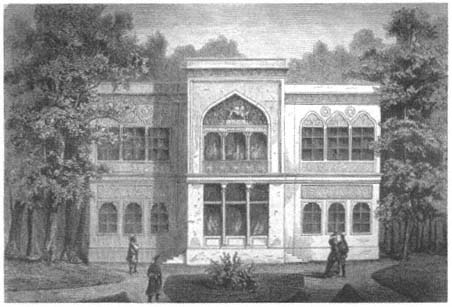
Figure 78.
Persian pavilion, Vienna, 1873 (L'Esposizione universale di Viena, no. 5).
Ali Qapu Palace (Fig. 79). For visitors, this was the ultimate expression of Oriental luxury. A guidebook to the exposition stated that the grand salon, "with millions of pieces of glass adorning the stalactites of the ceiling," flashed like a huge diamond.[54] Another observer called the room enchanted, "a real salon from The Thousand and One Nights " that acquired an "absolutely magical" atmosphere when the candles were lighted.[55]
Iran made its greatest architectural statement in Paris in 1900 (Fig. 80). A French architect, Philippe Mériat, designed and supervised the construction of the Persian pavilion on the Rue des Nations for the Iranian government, which asked for a building modeled on the Madrasa Maderi Shah Sultan Husayn.[56] The exposition hall, however, did not rely solely on toe original model organized around a courtyard. In fact, the pavilion had four elaborate facades and no Interior courtyard; thus references to the original were restricted to particular elements. Moreover, the structure was topped by two colonnaded pavilions modeled after the Pavilion of the Forty Columns and the terrace of'Ali Qapu Palace in Isfahan. Visitors were dazzled by the octagonal columns carved in cypress; ceilings sculpted, painted, and gilded; and a floor of white marble.[57]
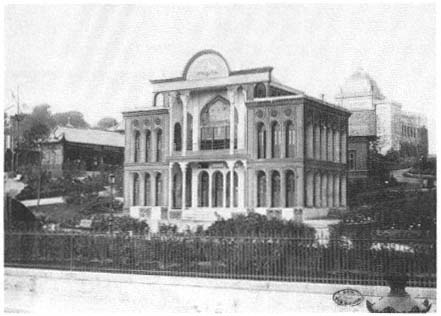
Figure 79.
Persian pavilion, Paris, 1878 (Bibliothèque Nationale, Département des
Estampes et de la Photographie).
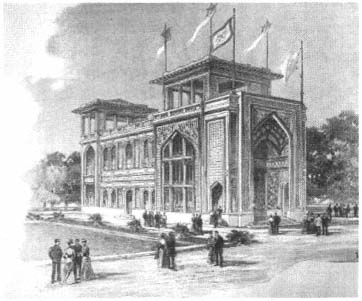
FIigure 80.
Persian pavilion, Paris, 1900 (L'Esposizione universale
del 1900 a Parigi ).
The facade on the Rue des Nations reinterpreted the great portal of the original madrasa as a tall iwan whose vault was decorated with stalactites; the tiles defining the borders of the portal were green, pink, orange, and different shades of blue. The overall effect was one of "grandeur, elegance, and bright gaiety." It was reported to be such a "perfect reproduction" that one observer lamented the lack of Iranian plants and waterworks on the Rue des Nations.[58] The interior of the building contained both a "magnificently furnished" reception hall and an "immense bazaar," where agricultural, industrial, and artistic products were exhibited.[59] The Hall of Honor, reserved for Shah Muzaffar ad-Din, was reportedly of the "first rank." It was lighted by two large stained-glass windows. On one, a Persian lion was depicted; on the other, lines by a contemporary poet were inscribed, glorifying the role of France and the city of Paris in modern civilization.[60] To Europeans such an integration of long inscriptions into architecture was novel. One observer remarked in awe: "Every facade is a real banner. They wrote everywhere: on the tiles, on the walls, on the glass."[61]
The attention given to the design and execution of this pavilion indicates the changing relations between Iran and Europe. Following Egypt and the Ottoman Empire, Iran had joined the "train of Western civilization."[62] Its exposure to the West led to a redefinition of its identity. Like the architecture of other Islamic powers at the world's fairs, that of Iran looked back to the nation's heritage, reinterpreting it according to the principles of Western architecture.
Tunisia and Morocco in the Pre-Protectorate Period
In 1867 Tunisia's and Morocco's displays in Paris seemed to some observers a deliberate escape from the economic and political upheavals the two countries were experiencing. Agricultural, industrial, and commercial spheres were omitted: instead, there were palaces with exuberant interiors and furniture, royal costumes, and armor—simply "everything that glitters, shines, and adorns.[63] Others noted the artistic value of the Tunisian and Moroccan pavilions. Alfred Norman claimed that they
were important not only for their size, but also for their tastefulness, their picturesque effect, and especially the brand new and charming sensation that they
arouse in us. . . . [Here was] a particular type of dwelling, where art was not excluded . . . from everyday activities.[64]
The purpose of the Tunisian pavilion was similar to that of the Egyptian selamlik and the Ottoman Pavillon du Bosphore: on his visits to the exposition, the Tunisian bey rested in the "grand palace" on the Champ de Mars (Figs. 81–82; see also Fig. 26). A duplicate of the Bardo Palace in Tunis, it was designed by the French architect Alfred Chapon. Six statues of lions framed the escaliers d'honneur, which led to a colonnaded porch and, inside, a vestibule. To the right of the vestibule was the domed "throne room" in the "purest Moorish style." The hall of the guards and the hall of the prime minister Mustafa Khaznadar were to the left. The prime minister's hall provided access to the bey's chambre d'honneur, also called Bayt al-Basha. Here, in a section separated by musharabiyya s, the Bey could hold private conferences.
At the core of the building was the patio, which gave access to the bey's private quarters—a vast room decorated in "unheard-of luxury and taste" that once again evoked The Thousand and One Nights . Brilliantly colored tiles sent from Tunisia added to the effect created by beautiful carpets and embroideries; gold-painted elements unified the space. The dazzling effects were greatest in the gilded dome. On a wall was a line from the Qur'an—"Happy is the land governed by the sadiq " (that is, "the just, the rightful")—that made a graceful pun on the name of the current bey, Muhammad al-Sadiq. On one side of the room, a stairway, hidden by a curtain, led to the harem, accessible only to the bey.
In the palace was a museum filled with Roman and Phoenician antiquities from Carthage, along with a huge café and a barbershop, accessible from the main street, that embodied two elements of Tunisian public life the exposition organizers saw as typical. The basement housed the stable.[65]
In 1878 the Tunisian pavilion was a more modest structure near the Algerian Palace. A square building with plain facades and a central courtyard with the inevitable fountain, it followed, on a much simpler level, the precedent of the 1867 palace, though its exterior was described as "grim and sad," like "all Turkish, Arabic, Moorish, and Persian buildings."[66] Inside, however, the
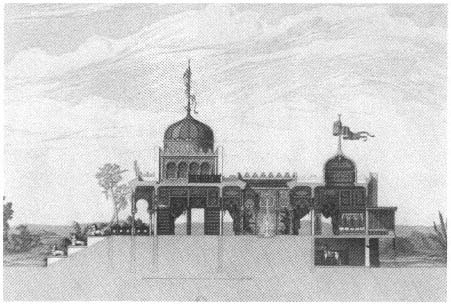
Figure 81.
Tunisian Palace of the Bey, section, Paris, 1867 (Normand L'Architecture
des nations étrangres ).
"multicolored Moorish design" was lively; ceilings were covered with rich mosaics, and the effect was altogether cheerful and picturesque.[67]
Stables and bedouin tents also played their part—in both the Tunisian displays (see Fig. 26) and the Moroccan. In 1867 in Paris, Morocco was represented by a large imperial tent and two smaller tents for guards next to the Tunisian section.[68] Nearby was a modest stable whose most striking feature was a fountain in white marble, decorated with bright tiles.[69] The pyramid-shaped tent made of camel hair reappeared in Paris in 1878, again as part of the "Oriental park." Inside, as in 1867, the tent was lined with couches covered with thick carpets; bric-a-brac, from large wooden wedding trunks to narghiles, completed the decor.[70] But now there were additions to the Moroccan compound: shops and a main pavilion, called the Moroccan villa. The villa consisted of four rooms, richly decorated and organized around a courtyard.[71] In 1889 and 1900, Morocco's pavilions, again with courtyards, had simple facades highlighted by detailed portals and square towers modeled after minarets.
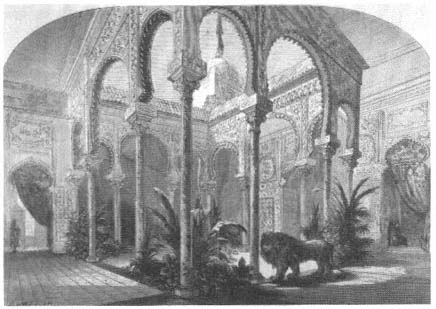
Figure 82.
Courtyard of the Tunisian palace, Paris, 1867 ( L'Exposition universelle de
1867 illustrée ).
Algeria and Tunisia under French Rule
Because Algeria was France's first and most important Muslim colony, its presentation to the world was a major concern, and French officials experimented with various possibilities. In 1867 Algeria was represented in the French exhibit as a "trophy," "a new territory reconquered by civilization after twelve centuries of barbarian rule." Inside the Galerie des Machines the Algerian display, modestly demarcated by palm trees, showed raw materials (Fig. 83). To display Arabs and their civilization, a douar, or Arabian village, was set up in the southwestern part of the park, near the Porte de la Grenelle. A group of camels sat in the center of a circle of tents while their caretakers, brought to Paris "to give an idea of the true Arab type," dozed inside.[72]
This modest exhibit contrasted with the next one in Paris in both scale and architectural ambition. The Algerian palace in 1878 was a massive mosquelike building, 40 by so meters (Figs. 84–85), its exterior dominated by four towers, its plain white walls unfenestrated. The interior, however, was more of a caravansary, where the products of two thousand exhibitors were displayed.[73]
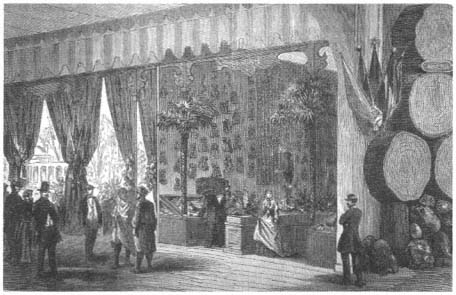
Figure 83.
Algerian displays of raw materials, Paris, 1867 ( L'Exposition aniverselle de
1867 illustrée ).
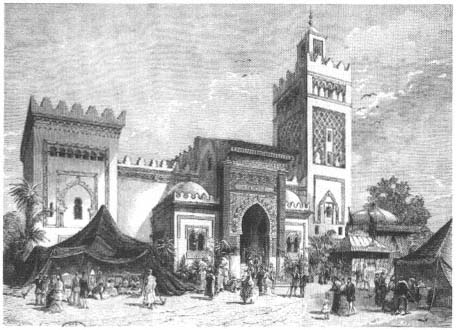
Figure 84.
Algerian palace, Paris, 1878 (Bibliothèque Nationale, Département des
Estampes et de la Photographie).
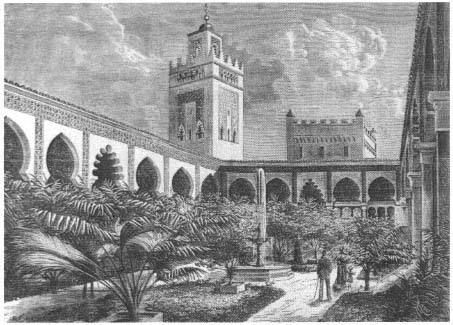
Figure 85.
Courtyard of the Algerian palace, 1878 ( L'llustration, 10 August 1878).
Daylight came in through the central courtyard, planted with palms and roses and containing a fountain. Components of the structure had their origins in monuments in the city of Tlemcen: the 30-meter-high minaret replicated that of the fourteenth-century Mosque of al-Mansur, and the portal came from the Mosque of Sidi Bou-Madina; the ribbed dome of the vestibule imitated the mihrab dome of the Great Mosque of Tlemcen. The most important space in the building was the rotunda-shaped Salon du Maréchal, the reception hall of the French marshal; it was on axis with the main entrance and was lighted dramatically by spherical stained glass windows.[74] With its allusion to the appropriation of local architecture by the colonial power, this room served as a political symbol.
The idea of architectural fragments so dominated the Algerian display that the portal of the al-Kebir mosque in Algiers was erected as a freestanding structure near the exposition palace (Fig. 86).[75] Out of its context the portal served as an archway, but because of its seemingly random placement, it was also a picturesque "found object."
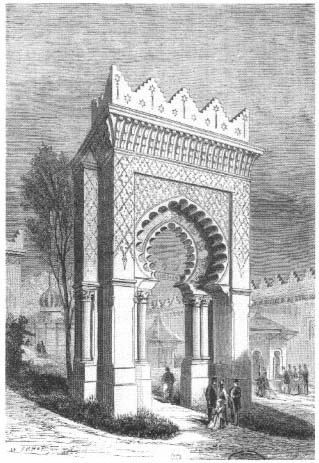
Figure 86.
The porta of al-Kebir mosque, Paris, 1878 (Bibliothèque
Nationale, Département des Estampes et de la Photographie).
Like the 1878 palace, the main Algerian pavilion at the 1889 Paris fair, designed by Albert Ballu and Emile Marquette (Fig. 87), was an introverted structure with courtyards, plain exterior facades with arched portals and porticoes, and a square minaret (not visible in the illustration) modeled after that of the Mosque of Sidi'Abd al-Rahman, which was topped with a French flag. A dome, also inspired by the Mosque of Sidi'Abd al-Rahman, covered the central space.[76] The interior decoration displayed a "capricious geometry"; one journalist argued that it was the "product of a dry imagination, a cold, me-
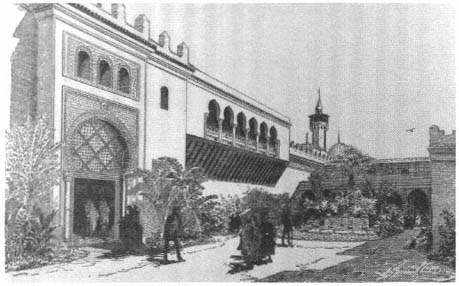
Figure 87.
Courtyard of the Algerian palace, Paris, 1889 (Monod, L'Exposition
universelle de 1889, vol. 2).
thodical barbarity without exuberance," because "the Arab never had a feel for plasticity; his genius was only in mathematics and colors."[77] Although this viewpoint adopts the rationalist theories of Islamic architecture rather than earlier theories of Islamic architecture as a sensuous fantasy, it still presents Islamic architecture in a negative light, denying that the Muslim artist and architect had any creative flexibility. Ironically, the exposition pavilions were considered Islamic architecture, despite their French authorship, at the same time that the neo-Arabian buildings erected in the colonies were considered French.
As noted in the previous chapter, Algeria in 1900 occupied the "place of honor" in the Trocadéro Park. Albert Ballu, the architect of the Algerian palace, had given this imposing structure an unadorned exterior to reflect the "Muslims' contempt of worldly things" (see Fig. 52).[78] The walls were a "luminous white," with bands of tiles on the upper levels and a crenellated roofline. The facade on the Seine was the structure's most elaborate, with its monumental stairway leading to an arched portico. A minaret 28 meters high, a replica of that of the Mosque of Sidi Bou-Madina in Tlemcen, rose on one side of the stairway. The central dome of the palace was inspired by the Mosque of the Fishery in Algiers.[79]
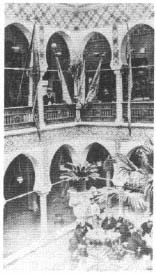
Figure 88.
Courtyard of the Algerian
palace, Paris, 1900 (L'Exposition
de Paris, vol. 3).
The palace basement was filled with antiquities and choice wines for tasting (Fig. 88).[80] On the ground floor, a large courtyard, a reproduction of the courtyard in the Bardo Palace in Algiers, "recalled the interior courts of Moorish houses in Granada and of Muslim harems, where solitude and freshness invite one to dream." In the middle, however, where tradition called for a fountain, there was a large, glassed-in model of the ruins of Timgad. In the galleries of the next floor, reached via the grand staircase outside, were exhibit of fabrics, guarded by "Turks and sipahis" (indigenous soldiers in the French army); a collection of engravings and cartoons from the time of the French conquest ("very curious and amusing historical documents"); a mineralogical exposition, complete with geological maps; and an exhibit of Algerian artists and French Orientalist painters.[81]
French colonizers presented the Algerian palace as a "didactic and demonstrative" exposition. Because the "attractions" were reserved for the section on the other side of the avenue bisecting the park, the palace lacked the picturesqueness Europeans were accustomed to by now. Although some visitors expressed disappointment, others noted with satisfaction that for once an Oriental exposition avoided being messy and commercial.[82]
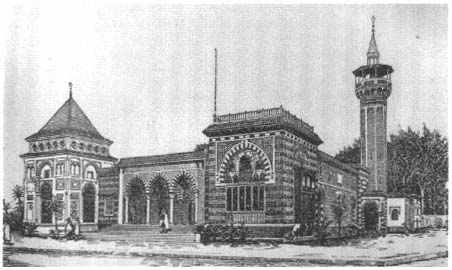
Figure 89.
Tunisian palace, Paris, 1889 (Monod, L'Exposition universelle de 1889, vol. 2).
Tunisia, which became a French colony in 1882, was summarized in 1889 by an elaborate and ambitious pavilion (Fig. 89). Following what could now be called a tradition in colonial representations, the young architect Henri-Jules Saladin incorporated architectural motifs from various monuments of Tunis into the facades of this "sober and elegant" building. A portal came from the Sulaymaniyya Madrasa and a facade from the Great Mosque of Kairawan, the dome and the minaret recalled the Sidi ben-Arous, verandas and musharabiyya s evoked the old houses of Tunis, and the tiled courtyard with a fountain in the middle was a feature of many Tunisian buildings. Tiles with floral motifs in blue and yellow, inspired by the tiles of the Bardo Palace, covered the walls. The building featured agricultural products and archaeological objects as well as schoolbooks that recorded "the progress achieved" under French rule.[83]
In the crowded Tunisian quarter of the Universal Exposition in Paris in 1900, again designed by Henri-Jules Saladin, there were two replicas of mosques. The first, a copy of the Mosque of Sidi-Maklouf in Kef, actually served as a mosque where Muslims could go for their daily prayers.[84] The second, a copy of the seventeenth-century Mosque of Sidi-Mahres in Tunis, then abandoned and in
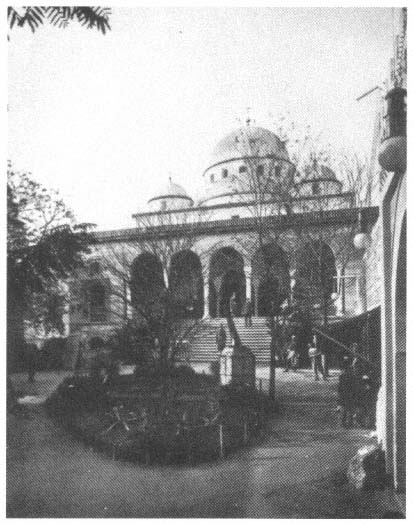
Figure 90.
Tunisian palace, Paris, 1900 (Exposition universelle internationale
de 1900, Paris, 1979).
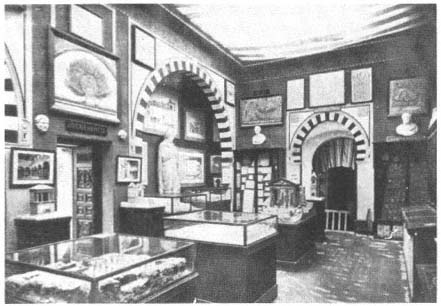
Figure 91.
Interior of the Tunisian palace, the archaeological section, Paris, 1900
(L'Exposition de Paris, vol. 3).
ruins, was transformed into an exhibition hall to display the agricultural, industrial, and commercial products of the regency (Figs. 90–91).[85] One room was reserved for documents pertaining to colonization, another for representative artwork from Tunisia's rich history.[86] Observers agreed enthusiastically that this white-domed "mosque" lacked only the light of the Tunisian sun to be real. To lend "authenticity," the moldings (geometric interlacings) were made in Tunisia by local artisans and shipped to Paris. The resident general of the colony, René Millet, joked that this replica—this "jewel"—lacked only the cow that had turned it into a stable back in Tunis.[87] Once again underscoring the building's authenticity, a French journalist sympathized, tongue-in-cheek, with the native who did not understand why he was not allowed to pray in this "mosque."[88]
The architecture of the Algerian and Tunisian colonies of France projected an image of Islam correlating with that of the noncolonial presentations. Yet the indigenous character of the pavilions played a different role in the colonial context, aggrandizing the image of France by making it more varied and complex. The greater the spectrum of differences in colonized cultures, the stronger was the impression of the colonizer's power and the vastness of his
domain. One French observer asked: "Are we not a grand Muslim nation, given our vast African colonies?"[89] In effect, the Islamic colonies were only a small part of the much larger French empire, which included West Africa, the Congo, Madagascar, Indo-China, and islands in the Caribbean. Pluralism suggested the empire's universality.
The Architects
The architects (almost all of them French) commissioned to design the buildings that represented the Islamic nations to the world are unfamiliar to most students of nineteenth-century French architecture: Léon Parvillée (1867, Ottoman Empire), Jacques Drévet (1867, Egypt; 1878, sections étrangères ), Albert Ballu (1889 and 1900, Algeria), Théodore Ballu (1878, Egypt), Alfred Chapon (1867, Tunisia), Marcel-Lazare Dourgnon (1900, Egypt), Adrien-René Dubuisson (1900, Ottoman), Emile Marquette (1889, Algeria), Henri-Jules Saladin (1889 and 1900, Tunisia), Paul-Jacques Aimé Baudry, and Philippe Mériat (1900, Iran). Although these men were not associated with the epoch-making buildings of the century, they did build in the mainstream, and their names appear frequently as exposition architects. Expositions provided platforms for architectural experimentation, as well as a means of livelihood, for many professionals. In Paris, where four expositions took place within thirty-six years, exposition architecture became a specialty.
Not only Islamic nations but also Luxembourg, Greece, China, Japan, and Russia, among others, commissioned French architects to design their pavilions. As the architectural historian Louis Hautecoeur pointed out in reference to the 1878 exposition, "Many nations trusted French architects to make their countries known."[90] France's influential role in this area was noted proudly by locals as "a sort of homage to [French] national art."[91]
Only some exposition architects knew firsthand the architecture of the places they represented. As noted earlier, Parvillée (a ceramicist, not an architect, by training) had documented and analyzed the Ottoman monuments of Bursa. Henri-Jules Saladin, a Beaux-Arts trained architect, had worked on archaeological missions in Tunisia and had published extensively on the antique and Muslim architecture of the country.[92] Jacques Drévet and Marcel-Lazare Dourgnon, who had also trained at the Ecole Supérieure des Beaux-Arts, had some practical experience with Islamic architecture. Drévet had developed a
project for the waterfront of Alexandria; though not implemented, it led to his assignment as the architect of the Egyptian pavilions in 1867. His expertise in "Oriental architecture," gained in 1867, led in turn to the French exposition committee's decision to select Drévet to design the foreign section (Iran, Siam, Annam, Tunisia, and Morocco) in the Trocadéro Park in 1878.[93] Moreover, his "serious and fruitful" studies of Egyptian architecture in preparation for the 1867 exhibition resulted in another project—a Cairo museum in a neo-Egyptian style, never realized.[94] Another exposition architect, Marcel-Lazare Dourgnon, responsible for the Egyptian pavilion in 1900, subsequently built the Museum of Antiquities in Cairo according to his own designs and undertook two other monuments in Cairo, both associated with the French government: the French Institute of Oriental Archaeology and the Monument to the French Soldier (fallen in the Napoleonic campaign) in the Latin cemetery of Cairo.[95] Albert Ballu (architect of the Algerian pavilions in 1889 and 1900) had an administrative position with the Commission of Historic Monuments in Aix-en-Provence and in Algiers. Later he became the general inspector of the Algerian museums and was involved in archaeological research in North Africa until 1925.[96] The other architects had no documented affiliation with the architecture of the Islamic countries whose pavilions they designed.
In this framework, Parvillée and Saladin stand out for their serious and detailed studies of Islamic architecture. Dourgnon must have been familiar with the Muslim architecture of Egypt and Ballu with that of Algeria, but neither demonstrated an analytical interest in the subject. Most likely the knowledge of the remaining architects depended on what they could glean from publications.
Conclusion
The International Colonial Exposition, held in the Bois de Vincennes outside Paris in 1931, celebrated the benefits of French colonialism. The architecture of this exposition can be seen as a conscious synthesis of earlier representations of non-Western societies at the fairs. In an article reviewing the architecture of this exposition, Pierre Courthion classified the pavilions into three types: original creations, stylized interpretations, and exact copies and reconstructions. He argued that the first appealed to artists, the second to dilettantes, and the third to ethnographers.[97] What he defined as original creations were products
of the age of modernism; stylized interpretations and exact copies, however, grew out of experimentation in the non-Western pavilions of the nineteenth-century universal expositions.
The building types allowed for the expression of regional differences. The architectural models that were copied or interpreted came from the homeland, although sometimes the purity of the original style was blurred, as, for example, in the Ottoman pavilion in Paris in 1900. A widespread cultural anxiety in the face of universalizing tendencies, along with a search for an appropriate architecture, resulted in the persistence of regional models—in both Islamic and modern European societies.[98] César Daly described the problem: "Modern society, powerless to express through art a harmony among souls that no longer exists, and powerless to attribute a fixed meaning . . . to the fundamental forms of architecture, [is] without the power to create and is constrained to borrow."[99]
The consequences of modernization for non-Western societies were even more serious than those for Western societies; non-Western societies risked losing their "national cultures" because of the homogenizing force of the "universal civilization," created by industrialization—itself a Western phenomenon.[100] Hippolyte Gautier had raised this issue as early as 1867. He had argued that the exposition provided the last opportunity for the Islamic nations to confirm their "characteristic physiognomy, their climatic, racial, and cultural originality"—in sum their "individuality"—and had warned that they risked losing their authenticity under the uniform color of "civilization."[101]
The expression of cultural identity was a primary theme in the Islamic architecture of nineteenth-century expositions, which themselves helped to differentiate national identities, to challenge "Islamic" as an all-inclusive term. The insistence on national identities in exposition architecture was a reaction both to the European tendency to consider Islamic civilization a single entity and to Ottoman suzerainty (except where the Ottoman Empire's own displays were concerned). As the governors and beys tried to establish their independence from the central Ottoman administration, they looked to local elements to define their cultures.[102] Nevertheless, regionalism at the world's fairs remained a stylistic affair, which did not extend to the types of buildings displayed. Although the pavilions cited specific structures from the place represented, the range of types was limited: mosques, caravanseries, souks, and so forth ap-
peared again and again, reiterating the signs and symbols commonly associated with a uniform Islam.
The architects of the exposition pavilions based their designs on one of two theoretical positions: rationalist and intuitionist. Although contradictory, both were deemed Islamic in essence. Rationalists looked for scientific rules of composition; Léon Parvillée was the most prominent among them. Intuitionists relied on feelings and fantasy as sources of inspiration; Jacques Drévet, who represented this approach, designed the Egyptian pavilions in 1867 in a mood of "artistic anarchy."[103] Both Parvillée and Drévet sought to understand the architecture of the cultures they represented at the expositions. But were they culturally equipped to do so?[104] Could it be argued that the "rules" Parvillée found in the monuments of Bursa were formulated in his own mind, based on his assumption (perhaps unconscious) that there was only one way of designing and that the Ottoman architects had worked within the same framework? And could it be argued that Drévet, although professing "artistic anarchy," was only pursuing a design methodology that he already knew?
More often than not, the theory was not articulated, and the architecture of the Islamic pavilions was influenced by the educational and professional background of the architect in charge. In general, the French architect's understanding of architecture was based on the long tradition of French academicism, which consequently shaped that architect's designs. The foreign vocabulary of Islamic architecture created no real problem because eclecticism was accepted by the Beaux-Arts tradition itself during the second half of the nineteenth century, and Islamic forms could easily be incorporated into its already crowded repertoire.
The pavilions erected on the grounds of the universal expositions raised serious and complex questions about cultural definition and the role of architecture in representing cultures. As temporary installations, they could be experimental and ask these questions boldly. And, because of the high visibility of the national pavilions and the attention they received in contemporary publications, both scholarly and popular, their regional and cross-cultural impact was disproportionate to the short life of the buildings themselves.